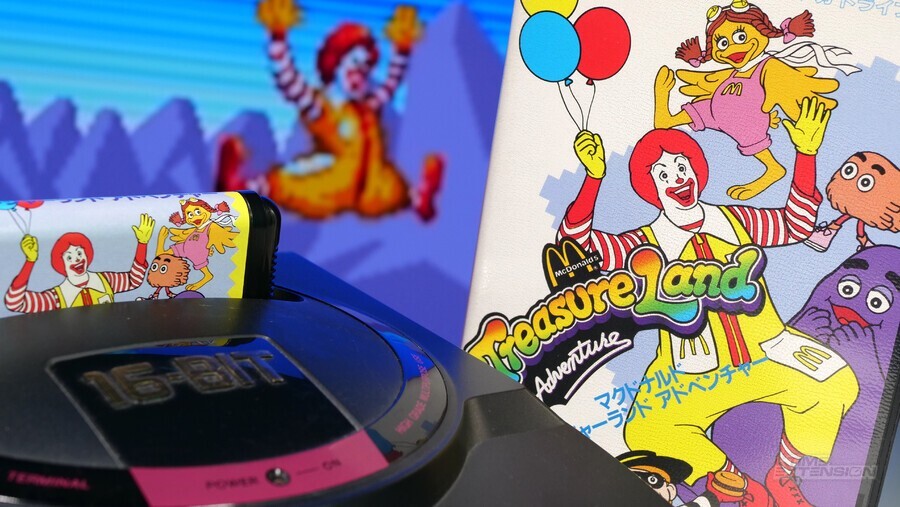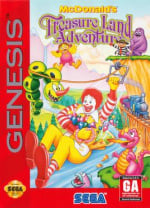
This year gave us a welcome instance of a major commercial brand doing something fun with a video game when McDonald's commissioned Grimace's Birthday for the Game Boy Color. The title – coded by Gumpy Function and Pearacidic – was made with passion and heart, and resulted in plenty of positive exposure for the fast food giant.
However, McDonald's attempts to promote its brand via interactive entertainment haven't always gone so smoothly. 1992's Global Gladiators, for example, caused some internal issues due to the fact that it featured very little in the way of McDonald's-related content – so much so that programmer David Perry (who would found Shiny Entertainment soon after) revealed that the company was annoyed that the action platformer didn't feature Ronald McDonald, its most recognisable character.
Fast forward a year, and Sega was looking to exploit the McDonald's license it had secured with an all-new video game for its Genesis / Mega Drive, and it enlisted the fledgling Japanese studio Treasure to create it. As recounted in John Harrison's excellent book Legends of 16-bit Game Development, Treasure founder Masato Maegawa brokered a deal whereby his new company would create this McDonald's video game and, in return, would receive the financial investment required to rent an office space and simultaneously work on its magnum opus, Gunstar Heroes.
That's not to say that the resultant game – 1993's McDonald's Treasure Land Adventure – was a poor product. While it's unlikely to rank very highly in the pantheon of Treasure's titles, it's still a solidly-made 2D platformer with some attractive visuals. However, making the game was something of a headache for Maegawa and his team, which also included director and designer Koichi Kimura, designer Kaname Shindo, sound designer Satoshi Murata and composer Katsuhiko Suzuki (Maegawa himself served as programmer on the project).
The bizarre thing is that, despite McDonald's objections to its brand not being prominent enough in the aforementioned Global Gladiators, it caused all kinds of issues for Treasure when it came to references being included in Treasure Land Adventure.
The first objections were, at least, partly understandable. "They wanted us to make an action game," Maegawa said in an interview with the Japanese publication Continue from 2001, translated by Harrison for his book. "But then they said Ronald isn't allowed to defeat any enemies. He's not that kind of character. I somehow got around that by convincing them, 'He's using his magic to send the enemies somewhere else.'"
Other issues were related to the game's hazards. "We showed them a version of the game right as we were about to finish development," continues Maegawa in the same 2001 interview. "This time, they told us we had to remove the lava since it's dangerous! We changed the palette for the lava to blue and called it water."
However, not all of the requests made by McDonald's were so easy to fix, and one of the most bizarre was to remove any trace of McDonald's food from the game – the sole reason for such a cross-media promotional product to exist, one would assume. "Someone at McDonald's told us we couldn't put hamburgers on the ground," Maegawa said at the Game Business Archive Live Talk 3 in 2017.
This alteration had a massive impact on the game, as, up to this point, Treasure had been using elements like burgers and fries as a core gameplay mechanic. "We had come up with this clever mechanic where the boss characters ate Ronald's hamburgers and drained his life," said Maegawa in 2001. "But of course, McDonald's didn't allow that. So, we changed the hamburgers into jewels, and for whatever reason, the bosses became 'jewel eaters' [laughs]. But seriously, what a pain!" Speaking to Retro Gamer magazine on the topic in 2021, Maegawa elaborated that "we were told not to treat McDonald's burgers with such disrespect."
Furthermore, the in-game shop – which, in the original pitch, would have resembled a McDonald's restaurant complete with food items and a waitress – had to be changed. In the final version, Ronald acts as the shopkeeper – so he is, in essence, buying items from himself. The food items are changed to jewels and rings.
Why were these changes made? As Harrison speculates, McDonald's was under pressure in the early '90s following negative press regarding the unhealthy nature of its food, and perhaps saw the inclusion of burgers and fries in McDonald's Treasure Land Adventure as a marketing step too far, hence their removal. However, it should be noted that by the time the SIMS-developed Japanese exclusive Ronald in the Magical World arrived on the Game Gear in 1994, food was permitted – and, furthermore, it was allowed to be placed on the ground, too.
Please note that some external links on this page are affiliate links, which means if you click them and make a purchase we may receive a small percentage of the sale. Please read our FTC Disclosure for more information.

